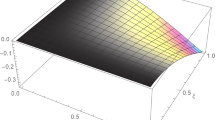Abstract
We consider solving the singular linear system arisen from the Poisson equation with the Neumann boundary condition. To handle the singularity, there are two usual approaches: one is to fix a Dirichlet boundary condition at one point, and the other seeks a unique solution in the orthogonal complement of the kernel. One may incorrectly presume that the two solutions are the similar to each other. In this work, however, we show that their solutions differ by a function that has a pole at the Dirichlet boundary condition. The pole of the function is comparable to that of the fundamental solution of the Laplace operator. Inevitably one of them should contain the pole, and accordingly has inferior accuracy than the other. According to our novel analysis in this work, it is the fixing method that contains the pole. The projection method is thus preferred to the fixing method, but it also contains cons: in finding a unique solution by conjugate gradient method, it requires extra steps per each iteration. In this work, we introduce an improved method that contains the accuracy of the projection method without the extra steps. We carry out numerical experiments that validate our analysis and arguments.


Similar content being viewed by others
References
Ammari, H., Kang, H., Kim, S.: Sharp estimates for the Neumann functions and applications to quantitative photo-acoustic imaging in inhomogeneous media. J. Differ. Equ. 253, 41–72 (2012)
Bochev, P., Lehoucq, R.B.: On the finite element solution of the pure Neumann problem. SIAM Rev. 47, 50–66 (2005)
Bramble, J.H., Pasciak, J.E., Schatz, A.H.: The construction of preconditioners for elliptic problems by substructuring I. Math. Comput. 47, 103–134 (1986)
Bramble, J.H., Thomee, V.: Pointwise bounds for discrete Green’s functions. SIAM J. Numer. Anal. 6, 583–590 (1969)
Brenner, S., Scott, R.: The Mathematical Theory of Finite Element Methods. Springer, New York (1994)
Bridson, R.: Fluid Simulation for Computer Graphics. CRC Press, London (2008)
Deeter, C.R., Gray, J.M.: The discrete Green’s function and the discrete kernel function. Discrete Math. 10, 29–42 (1974)
Evans, L.C.: Partial Differential Equations. American Mathematical Society, Providence (1998)
Gockenbach, M.S.: Understanding and Implementing the Finite Element Method. SIAM, Philadelphia (2006)
Gürlebeck, K., Hommel, A.: On the finite difference potentials and their applications in a discrete function theory. Math. Methods Appl. Sci. 25, 1563–1576 (2002)
Hwang, S.-G.: Cauchy’s interlace theorem for eigenvalues of Hermitian matrices. Am. Math. Mon. 111, 157–159 (2004)
Kenig, C.E.: Harmonic Analysis Techniques for Second Order Elliptic Boundary Value Problems. American Mathematical Society, Providence (1994)
Kolokolnikov, T., Ward, M.J., Wei, J.: Spot self-replication and dynamics for the Schnakenburg model in a two-dimensional domain. J. Nonlinear Sci. 19, 1–56 (2009)
Laasonen, P.: On the solution of Poisson’s difference equation. J. Assoc. Comput. Mach. 5, 370–382 (1958)
Lawler, G.F., Limic, V.: Random Walk: A Modern Introduction, Cambridge Studies in Advanced Mathematics, vol. 123. Cambridge University Press, Cambridge (2010)
Ng, Y.T., Min, C., Gibou, F.: An efficient fluid-solid coupling algorithm for single-phase flows. J. Comput. Phys. 228, 8807–8829 (2009)
Parlett, B.N.: The Symmetric Eigenvalue Problem. Prentice-Hall, Upper Saddle River (1998)
Purvis, J.W., Burkhalter, J.E.: Prediction of critical mach number for store configurations. AIAA J. 17, 1170–1177 (1979)
Saad, Y.: Iterative Methods for Sparse Linear Systems. SIAM, Philadelphia (2003)
Thomas, J.W.: Numerical Partial Differential Equations: Conservation Laws and Elliptic Equations. Springer, New York (1999)
Yoon, G., Park, J.-H., Min, C.: Convergence analysis on the Gibou–Min method for the Hodge projection. Comm. Math. Sci. (under review)
Acknowledgments
We greatly thank and acknowledge the reviewers for their comments which helped us to improve and clarify the manuscript. This research was supported by Basic Science Research Program through the National Research Foundation of Korea (NRF) funded by the Ministry of Education (2009-0093827).
Author information
Authors and Affiliations
Corresponding author
Rights and permissions
About this article
Cite this article
Yoon, M., Yoon, G. & Min, C. On Solving the Singular System Arisen from Poisson Equation with Neumann Boundary Condition. J Sci Comput 69, 391–405 (2016). https://doi.org/10.1007/s10915-016-0200-2
Received:
Revised:
Accepted:
Published:
Issue Date:
DOI: https://doi.org/10.1007/s10915-016-0200-2




